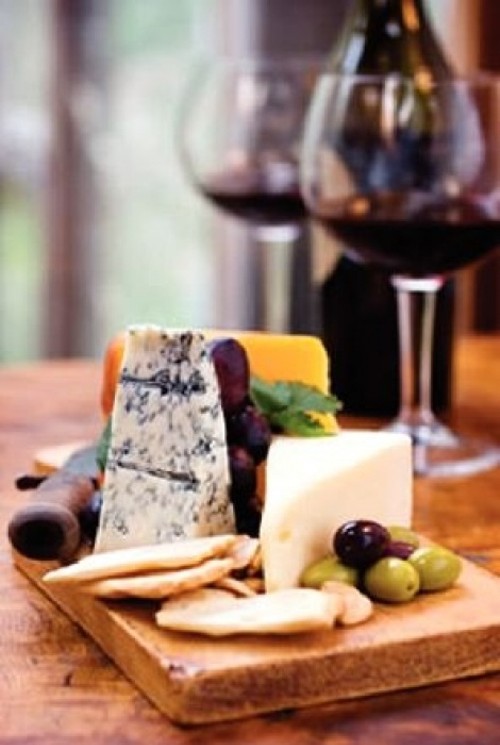In every genre of music, the manner
in which notes, chords and beats come
into synchrony determines the success
of a line, stanza or one-hit wonder. There
is a similar union—or, as it sometimes
goes, a fist-fight—of flavors and textures
when wine meets with food; the possibilities
are infinite. I’d bore holes in my
keyboard laboring over this bite and that
sip. However, by painting in broad strokes,
it’s possible to frame most encounters into
three wine/food scenarios.
In ascending order from the bottom:
The Chernobyl pairing. It’s disastrous.
Something in the alchemy between the otherwise
sound wine and the now-maligned
dish produces yelps of sensory disdain
from face to gut.
One notch up: Switzerland. After the
wine is introduced to the food, there is no
change in the flavors of the dish or the wine;
their effects on one another are neutral,
neither gets better nor worse.
And the most coveted and elusive:
Utopia. This foot-stamping,
glorious moment occurs when
components of a dish enhance,
highlight and extend coveted flavors,
nuances and textures in the
wine. The wine effortlessly reciprocates,
over and over.
Pairing red wine with meat and white
wine with fish is narrow in focus, but a good
start. And drinking what you like while eating
what you like is certainly an option. But why
settle for mediocrity when Utopia awaits?
By taking a moment to consider the
components in the glass and on the plate,
your odds of success will improve. Always
take weight and texture into consideration.
If a dish is delicate in flavor and
light in weight—scallop slivers atop an
airy, savory pastry, for example—a dense,
rich, heavy Chardonnay will rob it of its
delicacy. A lighter-bodied, crisp, un-oaked
Chablis or Sauvignon Blanc would fare better.
Conversely, look to bigger, heartier reds
like Cabernet or Syrah when serving stews
or other rich meals laden with protein.
Try to also gauge the intensity of flavors.
If a hearty poached monkfish is
dressed in a dense pomegranate-molasses
sauce, play off the sauce. Merlot would
work well, even in this antithetic scenario
of fish and red wine.
Matching or contrasting components is
also effective. Butter-poached King crab
will take on an even more rich and savory
texture when accentuated by a full-bodied,
buttery California Chardonnay. Offsetting
the spicy heat of a dish with the unfermented
grape sugars in an off-dry wine,
as found in many German Rieslings, works
wonders; the sweetness cancels out the
anesthetic effects of incendiary seasonings.
And, wine’s inherent acids and tannins
are essentially what make wine such
a loyal companion to food.
This last bit will reek of anatomy and
physiology and might sound icky, but it
should drive the point home. Acidity in
wine causes your mouth to water. This
“lubrication” stimulates your appetite
and helps to wash dairy fats like cheese
and cream sauces from your palate. Your
tongue is studded with tiny potholes, the
perfect place for animal fat to camp and
sedate your taste buds. Tannin—the component
that dries your cheeks, gums and
mouth—is the perfect artillery for polishing
your palate back into shape.
After failing miserably at playing Cupid
for a friend, I apologized. As he sighed,
shrugged his shoulders and leaned forward
with an upward palm gesture, he said, “If
you don’t play the game, you’ll never win.”
Keep experimenting with food and wine,
and the rewards will surely outweigh any
lost love towards this timeless coupling.
Louis Koppel is sommelier at Spencers for Steaks & Chops.
Speaking of...
-
Sipping Portugal
Vinho Verde is the perfect spring/summer sipper.
- May 10, 2011
-
Wine & Dine
A bounty of local wine dinners in May.
- May 3, 2011
-
Pinot & Pedicures
Tasting Robert Sinskey Wines in the most unusual of venues.
- Apr 26, 2011
- More »
More by Louis Koppel
-
The History & Buzz About Wine
A brief history of the nectar and our attraction to it.
- Sep 21, 2010
-
How to Decipher Wine Descriptions
Purple Prose & White Lies: How to unravel the tasting note.
- Aug 10, 2010
-
Wine & Wood
Get your mind out of the gutter; we’re talking about oak.
- May 25, 2010
- More »




